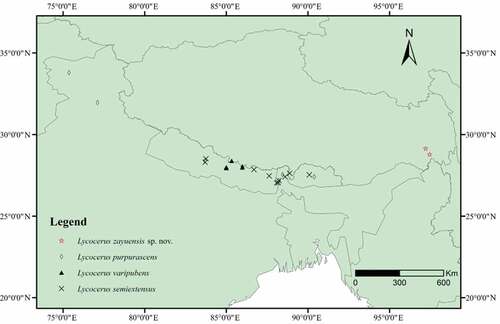Abstract
The Lycocerus varipubens species-group is defined to accommodate three previously described species and a new species from the Himalayan area, including L. varipubens, L. semiextensus, L. purpurascens comb. nov. & stat. reinst. and L. zayuensis sp. nov. L. purpurascens, originally described in Cantharis and first combined in Lycocerus here, is reinstated as a valid specific name to replace L. rubrispinis syn. nov., which is a replacement name for Cantharis rubripennis. Meanwhile, L. rubrispinis becomes a junior synonym of L. purpurascens. L. varipubens species-group could be distinguished from all other groups by the combination of following characters, the filiform antennae, pronotum wider than long, reddish-brown elytra with weakly or moderately developed longitudinal costae, all pro- and meso-outer claws each with a digtiform tooth in both sexes, and spermatheca with three spiral tubes. The species descriptions are provided with habitus photos, aedeagi, abdominal sternites VIII and reproductive systems of female. L. purpurascens and L. varipubens are recorded to China for the first time. In addition, a morphological phylogenetic analysis shows that the L. varipubens group is sister to L. purpureus group. A distribution map and a key to the species of this species-group are also provided.
http://www.zoobank.org/urn:lsid:zoobank.org:pub:7C82B6E4-9A71-4893-AD97-5692839D2236
Introduction
Soldier beetles of the genus Lycocerus Gorham, Citation1889 sensu Okushima (Citation2005) represent one of the most speciose cantharid genera, with over 300 species widely distributed in Oriental and southeastern Palaearctic regions (Delkeskamp, Citation1977; Kazantsev & Brancucci Citation2007). No subgenus has been proposed to subdivide this large group since its redefinition by Okushima (Citation2005), who suggested that no morphological character was valuable enough in the taxonomy of subgeneric level. Most recently, a morphology-based phylogeny of Lycocerus was constructed by Hsiao (Citation2021), and the result supported the synonyms of Athemus Lewis, Citation1895, Athemellus Wittmer, Citation1972, Mikadocantharis Wittmer & Magis, Citation1978, Andrathemus Wittmer, Citation1978 and Isathemus Wittmer, Citation1995 with Lycocerus in various cladistic methods. However, it had to be acknowledged that some species definitely showed more or less similarity in their morphology (Okushima Citation2005). Therefore, the compromise to solve this systematic problem was to define some species-groups for Lycocerus (Okushima, Citation2005), and this concept was followed by the others. Until now, a total of 13 species-groups have been defined within it (Okushima Citation2005; Okushima & Brancucci Citation2008; Okushima & Yang Citation2013; Yang et al. Citation2014; Hsiao & Okushima Citation2015, Citation2016; Hsiao et al. Citation2016; Okushima & Hsiao Citation2017, Citation2021; Xi et al. Citation2021a, Citation2021b), but the majority of the species remains unassigned, so much more work is left to be done. The phylogenetic analyses of Lycocerus by Hsiao (Citation2021) opposes the presumed relationships among the species-groups by Okushima (Citation2005), and the completion of the species-group assignation will help further investigation on the relationship within this large genus.
During our recent study, an interesting species of Lycocerus from Xizang, China was discovered. It looks similar to L. varipubens (Wittmer, Citation1978), L. semiextensus (Wittmer, Citation1995) and L. rubrispinis Kazantsev, Citation2007 (which is going to be replaced by L. purpurascens (Pic, Citation1911) here) in the appearance, including body shape, coloration and pubescence, as well as characteristics of tarsal claws, but is different from them in the structure of aedeagus, so it is new to the science and described in the present study. Further examination of their female reproductive systems showed that the spermatheca is distinctive and provided with three tubes, which has never been found in any other group (Okushima Citation2005; Okushima & Brancucci Citation2008; Yang et al. Citation2014; Hsiao & Okushima Citation2016a; Okushima & Hsiao Citation2017), so a new species group is necessarily defined to accommodate these species. Meanwhile, the phylogenetic position of this new species group within Lycocerus will be explored based on the morphological data using cladistic methods. Additionally, some more distribution or morphological information will be added for the previously described species.
Material and methods
Specimens studied
The studied material is preserved in the following collections: Institute of Zoology, Chinese Academy of Sciences, Beijing, China (IZAS); Naturhistorisches Museum Basel, Switzerland (NHMB); Muséum national d’Histoire naturelle, Paris, France (MNHN).
Terminology and techniques
Morphological terminology used in this study mainly follows that of Okushima (Citation2005). The abbreviations in the figures are as follows, male genitalia (bp: basal piece; dp: dorsal plate of each paramere; is: inner sac of median lobe; lp: laterophyse; ml: median lobe; te: tegmen; vp: ventral process of each paramere) and female genitalia (ag: accessory gland; di: diverticulum; sd: spermathecal duct; sp: spermatheca; ov: median oviduct; va: vagina).
Genitalia of both sexes and abdominal sternites VIII of females were dissected and cleared in 10% NaOH solution, and female genitalia were dyed with hematoxylin. Habitus photos were taken by a Leica M205A stereomicroscope, multiple layers were stacked using Combine ZM (Helicon Focus 5.3). Line drawings were made using a camera lucida attached to a Nikon SMZ1500 stereomicroscope, then edited in CorelDRAW 12 and Adobe Photoshop CS3.10.0.1.
Complete label data are listed for type specimens of the previously known species, using square brackets “[]” for our remarks and comments, [p] indicating that the following data are printed and [h] that they are handwritten. Quotation marks are used to separate data from different labels and a backslash “/” to separate data from different lines of the same label. For the additional specimens, quotation marks are used if their original labels are written in English. All the labels written in Chinese are transliterated into English. Body length is measured from the anterior margin of the clypeus to the elytral apex and body width across the humeral part of elytra.
The distribution map is produced by ArcGis 10.6 (Esri, Redlands, California, USA) and processed in the Adobe Photoshop CS5. The geographical information is based on the literatures (Wittmer Citation1978, Citation1995; Kazantsev & Brancucci Citation2007) and the material of the present study.
Phylogenetic analysis
Following the work of Hsiao (Citation2021), L. varipubens was sampled representing the L. varipubens group, and a state, “2. with three spiral tubes”, was added to the character 44 (Hsiao Citation2021: Table 3). In addition, as the replacement name for L. sichuanus Y. Yang et al. Citation2014 has been proposed in Xi et al. (Citation2021a) due to the secondary homonym, the name of the species sampled for L. hickeri group should be corrected as Lycocerus hickerimimus. The data matrix was edited manually and saved as “.tnt” format, and the analysis was carried out in TNT ver. 1.5 (Goloboff & Catalano Citation2016), using the implicit enumeration search with all characters unordered and unweighted. The assembled data matrix was also analyzed under the implied weighting (Goloboff et al. Citation2018) under K value 3. The character states were mapped on the most parsimonious tree using Winclada ver. 1.0 (Nixon Citation2002), with only unambiguous changes indicated.
Results and discussion
Taxonomy
Lycocerus varipubens species-group
Definition
Body 6.8–11.0 mm, antennae filiform or subfiliform, present with oval to round smooth impressions along outer margins of middle antennomeres in male. Pronotum wider than long, with lateral margins slightly or moderately diverging posteriorly. Elytra reddish brown, densely and coarsely punctate, matt, densely covered with short, decumbent reddish brown pubescence. Pro- and meso-outer claws each with a digtiform tooth at base in both sexes. Median lobe of aedeagus simple, without dorsal process. Vagina stout and extended apically into a thick duct; spermathecal duct relatively short; spermatheca provided with three spiral tubes, gradually narrowed apically, of which the basal one longest and the middle one shortest.
Included species
L. varipubens (Wittmer, Citation1978), L. semiextensus (Wittmer, Citation1995), L. purpurascens (Pic, Citation1911) comb. nov. & stat. reinst. and L. zayuensis sp. nov.
Distribution
All the species are restricted to the Himalayan area (), located in 27.04–33.80°N, 75.36–97.46°E, from the western to eastern Himalayas.
Figure 2. Type habitus, dorsal view (A. female; B–C. male): A. Cantharis rubripennis Pic, Citation1906 (holotype, MNHN); B. Athemus (Andrathemus) semiextensus Wittmer, Citation1995 (holotype, NHMB, CANTH00001301); C. Athemus (Andrathemus) varipubens Wittmer, Citation1978 (paratype, NHMB, CANTH00001479).
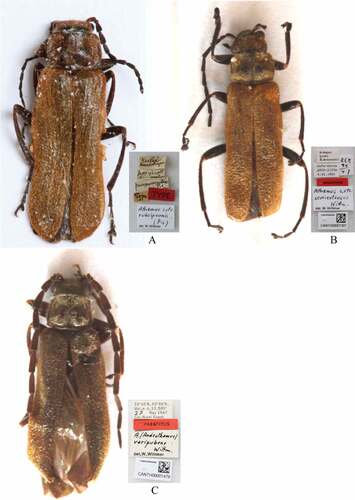
Figure 3. Habitus, dorsal view (male): A. Lycocerus purpurascens (Pic, Citation1911) (IZAS, IOZ(E)1390146); B. L.semiextensus (Wittmer, Citation1995) (IZAS, IOZ(E)1436784). Scale bars: 2.0 mm.
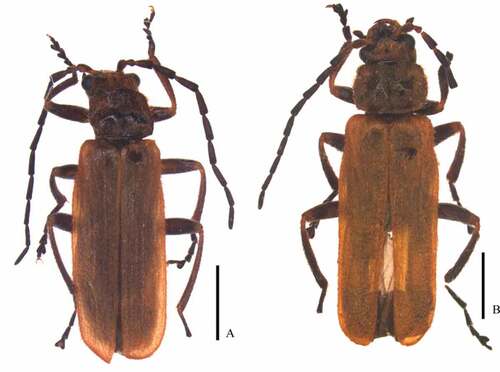
Remarks
L. varipubens group could be distinguished from all other species groups (Okushima Citation2005; Okushima & Brancucci Citation2008; Yang et al. Citation2014; Hsiao & Okushima Citation2016; Okushima & Hsiao Citation2017) by the spermatheca with three spiral tubes. Also, it is recognized by the combinations of the characers listed by Hsiao (Citation2021), including the body shape, coloration, and the shapes of eyes, antennae, pronotum and elytra, as well as the structures of tarsal claws in both sexes, aedeagus and female internal reproductive systems.
What’s noted here, in the statement of Principle of Priority (ICZN, 4th, article 23.1), the valid name of a taxon is the oldest available name applied to it, which also applies to the names to denote aggregates of species, and the precedence of such name is that which it has in the species group (ICZN (Citation1999), 4th, article 23.3.3). Although L. purpurascens (Pic, Citation1911) comb. nov. & stat. reinst. is the oldest name in this group, the name of L. purpurascens species-group has been already preoccupied by Okushima (Citation2005). The latter is originally proposed for L. purpurascens (Wittmer, Citation1978) which subsequently replaced with L. purpureus Kazantsev, Citation2007, and the species group name has been cited as L. purpureus species-group by Hsiao (Citation2021). In order to avoid the confusion, the next oldest name is applied to this new species group as L. varipubens species-group.
Key to the species of Lycocerus varipubens species-group
1. Aedeagus: ventral process of each paramere slightly bent dorsally in lateral view, laterophyses situated at dorsal side of median lobe, approaching each other and touching at apices2
– Aedeagus: ventral process of each paramere slightly bent ventrally in lateral view, laterophyses separated on lateral sides of median lobe, far from each other3
2. Aedeagus: ventral process of each paramere slightly shorter than dorsal plate; dorsal plate with inner apical angle acute, inner surface smooth at apical part, without any ridge (–F)L. semiextensus
– Aedeagus: ventral process of each paramere slightly longer than dorsal plate; dorsal plate with inner apical angle rounded, inner surface strongly ridged at apical part, the ridge obviously extruding over inner margin (–C)L. purpurascens
3. Pronotum black, slightly wider than long, elytral venations moderately developed (–D); aedeagus: dorsal plate of each paramere subparallel-sided, laterophyse slightly shorter than dorsal plate (–F)L. zayuensis sp. nov.
Figure 4. Habitus, dorsal view (A, C. male; B, D.female): A–B. Lycocerus varipubens (Wittmer, Citation1978)(A. IZAS, IOZ(E)1389491; B. IZAS, IOZ(E)1435456); C–D. L. zayuensis sp.nov.(C. IZAS, IOZ(E)1389662; D. IZAS, IOZ(E)1436781). Scale bars: 2.0 mm.
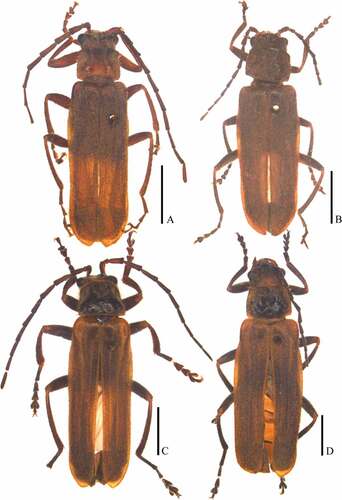
Figure 5. Aedeagus (A, D. ventral view; B, E. dorsal view; C, F. lateral view): A–C. Lycocerus purpurascens (Pic, Citation1911) (IZAS, IOZ(E)1390146); D–F. L.semiextensus (Wittmer, Citation1995) (IZAS, IOZ(E)1436784). Scale bars: 1.0 mm.
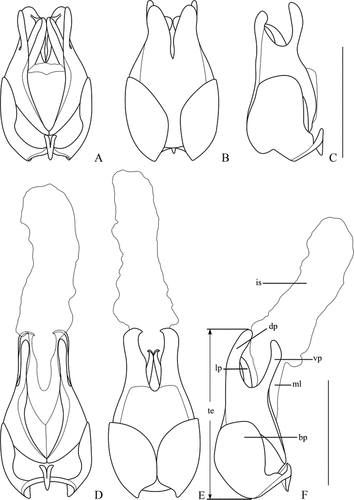
Figure 6. Aedeagus (A, D. ventral view; B, E. dorsal view; C, F. lateral view): A–C. Lycocerus varipubens (Wittmer, Citation1978) (IZAS, IOZ(E)1389491); D–F. L. zayuensis sp. nov. (IZAS, IOZ(E)1389662). Scale bars: 1.0 mm.

– Pronotum brown, obviously wider than long, elytral venations weakly developed (–B); aedeagus: dorsal plate of each paramere with inner margin protuberant in middle, laterophyse obviously shorter than dorsal plate (–C)L. varipubens
Lycocerus purpurascens (Pic, Citation1911) comb. nov. & stat. reinst. (, 3A, 5A–C, 7A, 8A)
Cantharis purpurascens Pic, Citation1911: 143. [junior synonym of Athemus (s.str.) rubripennis (Pic, Citation1906) by Wittmer Citation1995: 264]. Here: first combination in Lycocerus, comb. nov.; reinstated as a valid specific name, stat. reinst.
Cantharis rubripennis Pic, Citation1906: 83 [original description].
Themus rubripennis: Jacobson Citation1911: 675 [checklist].
Athemus (Andrathemus) rubripennis: Wittmer Citation1978: 158, (parte) [illustration and description of aedeagus].
Athemus (s.str.) rubripennis: Wittmer Citation1995: 264, fig. 120 [photo of aedegus].
Lycocerus rubrispinis Kazantsev, Citation2007:54. [replacement name for Cantharis rubripennis Pic, Citation1906, preoccupied by Telephorus rubripennis Hope, 1831: 26.] syn. nov.
Type material examined
Holotype () female at MNHN labeled: [h] “Kulu/Himachal Pradesh”, [h] “unreadable hand-written words”, “purpureopubens Pic”, [h] “Type”, [p] “TYPE”, [h] “Athemus s.str./rubripennis/Pic/det. W. Wittmer”.
Non-type material examined
China, Xizang: 1♂ (IZAS, IOZ(E)1390146), Nymlam, Dingrenbuqiao, 2600 m, 27.IV.1974, leg. X. Z. Zhang; 1♀ (IZAS, IOZ(E)1435454), Nymlam, Zham, 2600 m, 5.V.1966, leg. S. Y. Wang.
Descriptive notes
Male (). Aedeagus (–C): basal piece nearly as long as dorsal plate of each paramere; ventral process of each paramere straight in ventral view and slightly bent dorsally in lateral view, with apex narrowly rounded; dorsal plate slightly shorter than ventral process, about three times as long as wide, with inner margin slightly protuberant in middle, outer margin slightly sinuate near apical part, inner apical angle rounded in dorsal view, outer apical angle subrounded in lateral view, inner surface longitudinally and arcuately ridged near to inner and apical margins, the ridge obviously extruding over inner margin; laterophyse obviously shorter than ventral process, with apex sharply hooked and touching the other, slightly extruding over the ridge, the two laterophyses separated on dorsal side of the median lobe and approaching each other.
Female (). Abdominal sternite VIII (): triangularly emarginate in middle and on both sides of posterior margin, lateral emarginations slightly wider and much deeper than the middle one, the portion between lateral and middle emarginations slightly slender and narrowly rounded at apex, lateroapical angle subtruncate at apices, not reaching apices of the portion between lateral and middle emarginations.
Figure 7. Abdominal sternite VIII of female, ventral view: A. Lycocerus purpurascens (Pic, Citation1911) (IZAS, IOZ(E)1435454); B. L.semiextensus(Wittmer, Citation1995) (IZAS, IOZ(E)1435846); C. L.varipubens (Wittmer, Citation1978) (IZAS, IOZ(E)1390816); D. L. zayuensissp. nov. (IZAS, IOZ(E)1436781). Scale bars: A, C–D = 0.5 mm, B = 0.2 mm.

Internal organ of reproductive system (): vagina stout and abruptly thinned at ventroapical portion into a stout tube, where diverticulum and spermathecal duct arising separately; diverticulum moderately long and spiral, gradually thinned apically; spermathecal duct very short; spermatheca provided with three spiral tubes, of which the basal one (spI) about twice longer than diverticulum, the middle one (spII) about one-fourth length of spI, the apical one (spIII) about three times longer than spII; accessory gland directly opening near base of spIII, thin and slightly shorter than spIII.
Figure 8. Internal organ of female reproductive system, lateral view. A. Lycocerus purpurascens (Pic, Citation1911) (IZAS, IOZ(E)1435454); B. L.semiextensus (Wittmer, Citation1995) (IZAS, IOZ(E)1435846); C. L.varipubens (Wittmer, Citation1978) (IZAS, IOZ(E)1390816); D. L. zayuensis sp. nov. (IZAS, IOZ(E)1436781). Scale bars: 1.0 mm.
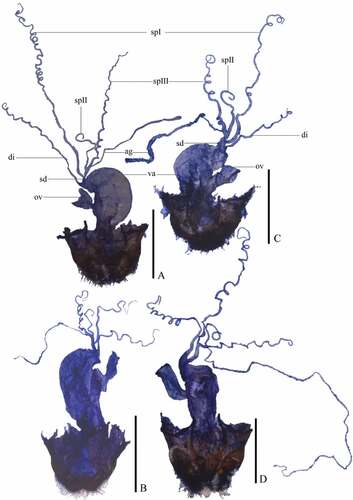
Figure 9. The majority consensus tree of 3 most parsimonious trees of diverse Lycocerus Gorham obtained by implicit enumeration search under equal weighting (L = 97; CI = 55; RI = 70). Black circles indicate synapomorphies; white rectangles indicate parallelisms or reversals; character numbers are given above circles, and character states are labelled below circles.
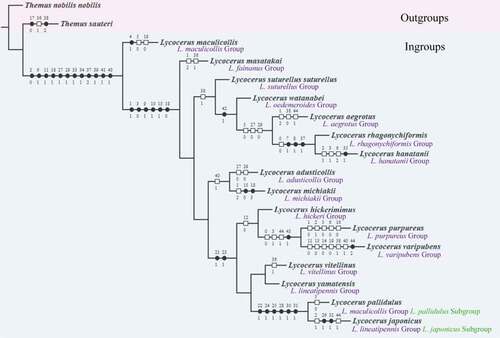
Remarks
Cantharis purpurascens Pic, Citation1911 was synonymized with Athemus (s.str.) rubripennis (Pic, Citation1906) by Wittmer (Citation1995). However, this was neglected by Kazantsev and Brancucci (Citation2007) that the former was not listed as a synonym of the latter in the Palaearctic Catalogue. Meanwhile, Athemus (s.str.) rubripennis (Pic, Citation1906) originally described in Cantharis L. and found to be a primary homonym of Telephorus rubripennis Hope, 1831, so its name was replaced with Lycocerus rubrispinis by Kazantsev (Citation2007).
According to the Principle of Priority, it requires that if a name in use for a taxon is found to be unavailable or invalid it must be replaced by the next oldest available name from among its synonyms (ICZN, 4th, article 23.3.5). Therefore, L. purpurascens (Pic, Citation1911) with first combination in Lycocerus should be reinstated as the valid name for this species, and L. rubrispinis Kazantsev, Citation2007 is a junior synonym at the moment.
Distribution
China (new record: Xizang); India, Nepal, Bhutan.
Lycocerus semiextensus (Wittmer, Citation1995) (, 3B, 5D–F,7B, 8B)
Athemus (Andrathemus) rubripennis Pic ─ Wittmer Citation1978: 158, (parte) [misidentification].
Athemus (Andrathemus) semiextensus Wittmer, Citation1995: 264, figs. 123, 124 [original description].
Lycocerus semiextensus: Kazantsev & Brancucci Citation2007: 253 [catalogue].
Type material examined
Holotype () male at NHMB labeled: [p] “E-Nepal/Koshi/M. Brancucci”, [p] “Gufa-Gorza/2800-2100 m/4.VI.1985”, [p] “HOLOTYPUS”, [h] “Athemus s. str./semiextensus/Wittm./det. W. Wittmer”, [p] “CANTHARIDAE/CANTH00001301”.
Non-type material examined
China, Xizang: 1♂ (IZAS, IOZ(E)1436784), Chomo, 2800 m, 8.VI.1961, leg. L. Y. Wang; 1♂ (IZAS, IOZ(E)1435842), Chomo, 2800 m, 5.VI.1961, leg. L. Y. Wang; 1♀ (IZAS, IOZ(E)1435849), Chomo, 2800 m, 7.VI.1961, leg. L. Y. Wang; 1♀ (IZAS, IOZ(E)1435846), Chomo, 2800 m, 6.VI.1961, leg. L. Y. Wang.
Descriptive notes
Male (, 3B). Aedeagus (–F): basal piece obviously shorter than dorsal plate of each paramere; ventral process of each paramere straight in ventral view and slightly bent dorsally in lateral view, with apex narrowly rounded; dorsal plate slightly longer than ventral process, moderately narrowed, about four times as long as wide, with inner margin slightly protuberant in middle, outer margin bisinuate, inner apical angle acute in dorsal view, outer apical angle rounded in lateral view, inner surface smooth; laterophyse obviously shorter than ventral process, with apex sharply hooked and touching the other, extruding over the middle emargination between dorsal plates, the two laterophyses separated on dorsal side of the median lobe and approaching each other; inner sac lengthened apically, nearly as long as tegmen.
Female. Abdominal sternite VIII (): triangularly emarginate in middle and roundly emarginate on both sides of posterior margin, lateral emarginations much wider and slightly deeper than the middle one, the portion between lateral and middle emarginations acute at apex, lateral emarginations slightly membranous at bottom, lateralapical angles widely rounded at apices, not reaching apices of the portion between lateral and middle emarginations.
Internal organ of reproductive system (): vagina stout and abruptly thinned at ventroapical portion into a stout tube, where diverticulum and spermathecal duct arising separately; diverticulum moderately long and spiral; spermathecal duct short; spermatheca provided with three spiral tubes, of which the basal one (spI) nearly as long as diverticulum, the middle one (spII) about 0.4 times as long as spI, the apical one (spIII) nearly as long as spI; accessory gland directly opening near base of spIII, slightly longer than spIII.
Distribution
China (Xizang); India, Nepal, Bhutan.
Lycocerus varipubens (Wittmer, Citation1978) (, 4A–B, 6A–C, 7C, 8C)
Athemus (Andrathemus) varipubens Wittmer, Citation1978: 157, [original description].
Lycocerus varipubens: Kazantsev & Brancucci Citation2007: 254 [catalogue].
Type material examined
Paratype () male at NHMB labeled: [p] “28°00′N, 85°00′E/Mal.tr. 6.10, 500′/27 May 1967/ Canad. Nepal Exped”., [p] “PARATYPUS”, [h] “A. (Andrathemus)/varipubens/Wittm./det. W. Wittmer”, [p] “CANTHARIDAE/CANTH00001479”.
Non-type material examined
China, Xizang: 1♂ (IZAS, IOZ(E)1389491), Nymlam, Zham, 2650 m, 15.V.1966, leg. S. Y. Wang; 1♂ (IZAS, IOZ(E)1435455), same data as the proceeding one; 1♂ (IZAS, IOZ(E)1390098), Nymlam, Zham, 2250 m, 8.V.1974, leg. X. Z. Zhang; 1♂ (IZAS, IOZ(E)1436934), Nymlam, Zham, 2250 m, 10.V.1974, leg. X. Z. Zhang; 1♂ (IZAS, IOZ(E)1367315), same data as the proceeding one; 1♂ (IZAS, IOZ(E)1436935), Nymlam, Zham, 2250 m, 11.V.1974, leg. X. Z. Zhang; 1♂ (IZAS, IOZ(E)1390443), same data as the proceeding one; 1♂ (IZAS, IOZ(E)1390438), Nymlam, Zham, 2250 m, 12.V.1974, leg. X. Z. Zhang; 1♂ (IZAS, IOZ(E)1390442), Nymlam, Zham, 2250 m, 17.V.1974, leg. X. Z. Zhang; 1♂ (IZAS, IOZ(E)1390441), same data; 1♀ (IZAS, IOZ(E)1435456), Nymlam, Zham, 2650 m, 15.V.1966, leg. S. Y. Wang; 1♀ (IZAS, IOZ(E)1390816), Zham, 2400 m, 22.VI.1975, leg. F. S. Huang; 1♀ (IZAS, IOZ(E)1390809), Zham, 2400 m, 4.VII.1975, leg. F. S. Huang; 1♀ (IZAS, IOZ(E)1390502), Xigazê, Gyirong, 2800 m, 25.VII.1975, leg. X. Z. Zhang.
Descriptive notes
Male (, 4A). Aedeagus (–C): basal piece nearly as long as dorsal plate of each paramere; ventral process of each paramere slightly bent inwards in ventral view and bent ventrally in lateral view, with apex obtusely rounded; dorsal plate slightly longer than ventral process, strongly narrowed, about three times as long as wide, with inner margin far from the other and slightly protuberant in middle, outer margin slightly sinuate, inner apical and outer apical angles subrounded, inner surface longitudinally and arcuately ridged near to outer and apical margins, the ridge slightly extruding over inner margin; laterophyse obviously shorter than ventral process, slightly bent dorsally and directing outwards, with apex hooked and opposite to the ridge on dorsal plate, the two laterophyses separated on lateral sides of the median lobe and far from each other; inner sac lengthened apically, nearly as long as tegmen.
Female (). Abdominal sternite VIII (): shallowly emarginate in middle and subroundly emarginate on both sides of posterior margin, lateral emarginations slightly narrower but much deeper than the middle one, the portion between lateral and middle emarginations obtuse-angled at apex, lateroapical angles subrounded at apices, not reaching apices of the portion between lateral and middle emarginations.
Internal organ of reproductive system (): vagina stout and abruptly thinned at ventroapical portion into a stout tube, where diverticulum and spermathecal duct arising separately; diverticulum moderately long and spiral, gradually thinned apically; spermathecal duct stout and very short; spermatheca provided with three spiral tubes, of which the basal one (spI) about twice longer than diverticulum, the middle one (spII) about one-third length of spI, the apical one (spIII) about half length of spI; accessory gland directly opening at the common base of spII and spIII, longer than spIII, abruptly expanded at basal one-fourth part.
Distribution. China (new record: Xizang); Nepal.
Lycocerus zayuensis Y. Yang et X. Yang sp. nov. (–D, 6D–F, 7D, 8D)
Type material examined
Holotype: ♂ (IZAS, IOZ(E)1389662), China, Xizang, Zayü, Gujing, 3100 m, 21.VI.1973, collector unknown. Paratypes: China, Xizang: 1♀ (IZAS, IOZ(E)1436933), same data as holotype; 1♀ (IZAS, IOZ(E)1389663), same data as holotype; 1♂ (IZAS, IOZ(E)1389661), Zayü, Gujing, 3200 m, 19.VI.1973, leg. F. S. Huang; 1♀ (IZAS, IOZ(E)1436781), same data as the proceeding one; 1♀ (IZAS, IOZ(E)1436932), Zayü, 2300 m, 17.VI.1973, leg. F. S. Huang.
Description of the new species
Male (). Body length: 9.5–10.0 mm (9.5 mm in holotype); width: 2.5–2.9 mm (2.5 mm in holotype). Body dark brown, except for head black, pronotum black, with anterior and posterior margins brown, elytra reddish brown, apices of femora and bases of tibiae brown. Body densely covered with short, recumbent reddish-brown pubescence, of which sparser on disc of pronotum than other parts. Head subrounded, slightly narrowed behind eyes, vertex faintly hollowed, surface semilustrous, densely and finely punctate; eyes moderately large and protruding, head width across eyes slightly wider than anterior margin of pronotum and slightly narrower than posterior margin; terminal maxillary palpomeres long triangular, apical half of inner margins arcuate; antennae filiform, extending to one-half length of the elytral when reclined, antennomere II shortest, slightly longer than wide at apices, III‒VII slightly widened apically, III about 2.5 times as long as II, III‒X each with an oblong to round smooth impression near apical part of outer margin, VII longest, VIII‒XI nearly parallel-sided, XI slightly longer than X and pointed at apices. Pronotum subquadrate, 1.1 times wider than long, widest at base, both anterior and posterior margin nearly straight, lateral margins moderately diverging posteriorly, anterior and posterior angles nearly rectangular, disc moderately convex at posterolateral parts, surface semilustrous, punctate like that on head. Elytra about 4 times longer than pronotum, 2.5 times longer than humeral width, which about 1.4 times wider than posterior margin of pronotum, lateral margins nearly parallel, elytral venations moderately developed, surface matt, largely punctate than that on pronotum. Legs slender, pro- and meso-outer tarsal claws each with a digitiform tooth at base.
Aedeagus (–F): basal piece nearly as long as dorsal plate of each paramere; ventral process of each paramere moderately bent inwards in ventral view and bent ventrally in lateral view, with apex obtusely rounded; dorsal plate slightly longer than ventral process, subparallel-sided, about twice as long as wide, with inner margin near to the other, outer margin slightly sinuate, apical margin rounded, inner apical angle rounded in dorsal view, outer apical angle obtusely rectangular in lateral view, inner surface longitudinally and arcuately ridged near to outer and apical margins, the ridge never extruding over inner margin; laterophyse slightly longer than ventral process, slightly bent dorsally and directing outwards, with apex hooked and opposite to the ridge on dorsal plate, the two laterophyses separated on lateral sides of the median lobe and far from each other; inner sac lengthened apically, shorter than tegmen.
Female (). Eyes less protruding than in male, antennae shorter, extending to basal one-third length of elytra when reclined, III‒X without impressions, head width across eyes slightly narrower than anterior margin of pronotum, pronotum slightly convex on posterolateral parts of disc.
Abdominal sternite VIII (): roundly emarginate in middle and on both sides of posterior margin, lateral emarginations much wider and deeper than the middle one, the portion between lateral and middle emarginations narrowly rounded at apex, lateral emarginations largely membranous at bottom, lateralapical angles slightly truncate at apices and exceeding over apices of the portion between lateral and middle emarginations.
Internal organ of reproductive system (): vagina stout and abruptly thinned at ventroapical portion into a stout tube, where diverticulum and spermathecal duct arising separately; diverticulum moderately long and spiral, gradually thinned apically; spermathecal duct short; spermatheca provided with three spiral tubes, of which the basal one (spI) slightly longer than diverticulum, the middle one (spII) about one-fourth length of spI, the apical one (spIII) about half length of spI; accessory gland directly opening at the common base of spII and spIII, thin and about three times as long as spIII.
Differential diagnosis
This new species is similar to L. varipubens (Wittmer, Citation1978) (, 4A–B), but can be distinguished by the subquadrate pronotum, antennae extending to elytral midlength, moderately developed elytral venations; the aedeagus with dorsal plate of each paramere subparallel-sided, about twice as long as wide, laterophyse slightly shorter than dorsal plate; female abdominal sternite VIII largely membraneous around lateral emarginations of posterior margin, lateroapical angles slightly truncate at apices, spermathecal duct and accessory gland relatively long. In comparison, L. varipubens has rectangular pronotum, with lateral margins parallel-sided, antennae extending to apical one-third length of the elytra, weakly developed elytral venations, aedeagus with dorsal plate of each paramere strongly narrowed, about three times as long as wide, laterophyse obviously shorter than dorsal plate; female abdominal sternite VIII never membraneous, lateroapical angles subrounded at apices, spermathecal duct and accessory gland relatively short.
Etymology
The specific name is derived from the name of the type locality, Zayü, Nyingchi, Xizang, China.
Distribution
China (Xizang).
Phylogenetic analyses
Maximum parsimony (MP) analysis under the implied weighting using K values 3 resulted in three most parsimonious trees. The produced topology of the majority consensus tree () (L = 97; CI = 55; RI = 70) is highly concordant with that of Hsiao (Citation2021: ), except for a different placement of L. aegrotus group. It shows that the L. varipubens group is sister to L. purpureus group, which is supported by the synapomorphy, modified accessory gland (abruptly expanded) (45:1). Although the close relationship is recovered for these two groups, regardless of the number of the spermathecal tubes, they could be easily distinguished from each other by the appearance. At present, only one species is included in the L. purpureus group, L. purpureus Kazantsev, Citation2007, which has orange body, blue and metallic shining elytra, also flat head, as well as absence of the antennal grooves in the male. Nevertheless, the phylogenetic relationships among the species groups within Lycocerus should be further investigated by molecular data in future to get a more well supported and objective phylogeny.
Acknowledgements
We are grateful to the late Dr Michel Brancucci (NHMB) for his great help to Y. Yang in studying on the taxonomy of Cantharidae. Also, we are indebted to Dr Antoine Mantilleri (MNHN) for proving us a chance to access the collections under his charge.
Disclosure statement
No potential conflict of interest was reported by the author(s).
Additional information
Funding
References
- Delkeskamp K. 1977. Pars 165, FascCantharidae. 1. Editio seconda. Pars 165, FascCantharidae. In: Wilcox JA editor. Coleopterorum Catalogus Supplementa. Netherlands: W. Junk, The Hague. pp. 1–485.
- Goloboff PA, Catalano SA. 2016. TNT version 1.5, including a full implementation of phylogenetic morphometrics. Cladistics 32(3):221–238. DOI:10.1111/cla.12160.
- Goloboff PA, Torress A, Arias JS. 2018. Weighted parsimony outperforms other methods of phylogenetic inference under models appropriate for morphology. Cladistics 34(4):407–437. DOI:10.1111/cla.12205.
- Gorham HS. 1889. Descriptions of new speicies and a new genus of Coleoptera of the family Telephoridae. Proceedings of the Zoological Society 1889:96–111.
- Hsiao Y. 2021. A preliminary phylogenetic study on the systematics of Lycocerus Gorham (Coleoptera: Cantharidae). Taiwanese Journal of Entomological Studies 6(2):13–23.
- Hsiao Y, Okushima Y. 2015. A new species of the genus Lycocerus from Taiwan (Coleoptera: Cantharidae). Elytra, Tokyo, New Series 5(1):109–113.
- Hsiao Y, Okushima Y. 2016. A new species of the genus Lycocerus from Taiwan (Coleoptera: Cantharidae). Acta Entomologica Musei Nationalis Pragae 56(1):255–264.
- Hsiao Y, Okushima Y, Yang PS, Ko CC. 2016. Taxonomic revision of the Lycocerus hanatanii species group (Coleoptera, Cantharidae), with the description of new species from Taiwan. European Journal of Taxonomy 170:1–33.
- International Code of Zoological Nomenclature. 1999. International code of zoological nomenclature adopted by the International Union of Biological Resources International Commission on Zoological Nomenclature. 4th ed. London: The International Trust for Zoological Nomenclature.
- Jacobson GG. 1911. Zhuki Rossiii Zapadnoy Evropy. Rukovodstvo k opredeleniyu zhukov. In: Devrjen AF, editor. Vypusk 9. Russia: St-Pétersburg. pp. 641–720.
- Kazantsev SV. 2007. New acts and comments: Cantharidae. In: Löbl I, Smetana A, editors. Catalogue of Palaearctic Coleoptera. Vol. 4. Denmark: Apollo Books, Stenstrup. pp. 47–54.
- Kazantsev SV, Brancucci M. 2007. Cantharidae. In: Löbl I, Smetana A, editors. Catalogue of Palaearctic Coleoptera. Vol. 4. Denmark: Apollo Books, Stenstrup. pp. 234–298.
- Lewis G. 1895. On the Dascillidae and malacoderm Coleoptera of Japan. The Annals and Magazine of Natural History 16(6): 98–122.
- Nixon KC. 2002. WinClada ver. 1.00.08. Published by the author. Ithaca, New York.
- Okushima Y. 2005. A taxonomic study on the genus Lycocerus (Coleoptera, Cantharidae) from Japan, with zoogeographical considerations. Japanese Journal of Systematic Entomology, Monographic Series 2:1–383.
- Okushima Y, Brancucci M. 2008. A remarkable new species of the genus Lycocerus Gorham, 1889 from Laos and Vietnam (Coleoptera, Cantharidae). Entomological Basiliensia Et Collectionis Frey 30:41–47.
- Okushima Y, Hsiao Y. 2017. Revision of the Lycocerus fainanus group (Coleoptera, Cantharidae), with description of a new species from Taiwan. Special Bulletin of the Coleopterological Society of Japan 1:121–130.
- Okushima Y, Hsiao Y. 2021. An additional new species of the Lycocerus oedemeroides species-group (Coleoptera, Cantharidae) from Taiwan. Elytra, Tokyo, New Series 11(Supplement):165–172.
- Okushima Y, Yang YX. 2013. Two new species of the subfamily Cantharinae (Coleoptera, Cantharidae) from Taiwan. Elytra, Tokyo, New Series 3(1):89–96.
- Pic M. 1906. Noms nouveaux et diagnoses de “Cantharini” (Telephorides) européens et exotiques.L. Échange, Revue Linnéenne 22:81–85.
- Pic M. 1911. Coléoptères exotiques nouveaux ou peu connus. L’ Échange, Revue Linnéenne 27:142–144.
- Wittmer W. 1972. Beitrag zur Kenntnis der palaearktischen Cantharidae und Malachiidae (Col.). Entomologische Arbeiten aus dem Museum G. Frey. 23:122–141.
- Wittmer W. 1978. Ergebnisse der Bhutan-Expedition 1972 des Naturhistorisches Museums in Basel. Coleoptera: Fam. Cantharidae (4. Teil) und Bemerkungen zu einigen Arten aus angrenzenden Gebieten. Entomologica Basiliensia 3:151–161.
- Wittmer W. 1995. Zur Kenntnis der Gattung Athemus Lewis (Col. Cantharidae). Entomologica Basiliensia 18:171–286.
- Wittmer W, Magis N. 1978. Zur Kenntnis einiger mit Cantharis L. verwandter Gattungen (Coleoptera, Cantharidae). Bulletin & Annales de la Societe Royale Belge d'Entomologie 114(4‒6):133‒139.
- Xi HC, Wang YN, Liu T, Yang XK, Liu HY, Yang YX. 2021b. Spatial origin and diversification of the Lycocerus fainanus species group (Coleoptera, Cantharidae), with descriptions of four new species from China and Vietnam. Insects 12(5):445. DOI:10.3390/insects12050445.
- Xi HC, Wang YN, Yang XK, Liu HY, Yang YX. 2021a. New species and taxonomic notes on Lycocerus hickeri species-group (Coleoptera, Cantharidae). Zootaxa 4980(3):541–557. DOI: 10.11646/zootaxa.4980.3.5.
- Yang YX, Su JY, Yang XK. 2014. Description of six new species of Lycocerus Gorham (Coleoptera, Cantharidae), with taxonomic note and new distribution data of some other species. Zookeys 456:85–107. DOI: 10.3897/zookeys.456.8465

